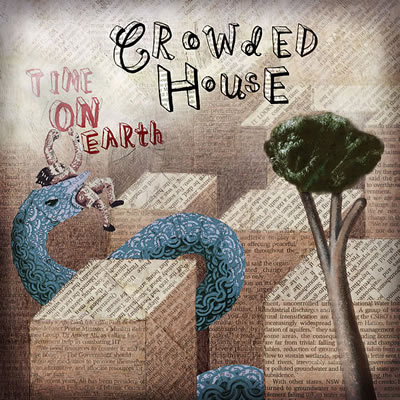
A Conversation with Nick Seymour of Crowded House
Puremusic: It's a happy day when a new Crowded House record appears.
Nick Seymour: Oh, good.
PM: It's been so long, and it sounds so great.
NS: You've had a chance for listening, then.
PM: Oh, yeah, many times. And it's such a satisfying record. I mean, it's the first one in 14 years, right?
NS: Yeah.
PM: Wow, so that's got to be an incredible feeling. And all the classic songwriting and the sound of Crowded House is in full effect, although the mood is a little more serious, is that fair to say?
NS: Yeah, I mean, I guess it depends on the records that you compare. Are you familiar with the last studio record?
PM: Yes, that's true, not so serious compared with that.
NS: Together Alone, which was our last studio album, I listen to and find it sometimes quite dark sounding, and yet it had songs like "Distant Sun" on it that were regarded as sort of classic Crowded House. But when I listen to that it always seems to me that because people can remember such upbeat singles from Crowded House on all four studio albums, when they hear a collection of songs they have to re-jig their awareness of what type of band we are. It's hard to define us as a category, but one thing we do have is melancholia. And I think we've always been a band that plays in minor keys.
PM: Right.
NS: But it's just that we are remembered for songs such as "Weather With You" that's got a big chorus at the end of it, or a song like "Something So Strong." But "Don't Dream It's Over" is kind of a dark sounding song, but it has a sense of optimism in the chorus.
PM: Right. In several of those so-recalled upbeat songs, there are plenty of minor chords in the verse that open up on the chorus.
NS: Yeah, absolutely. That's possible. And "Four Seasons in One Day," it's a kind of very mellow, reclusive, someday, rainy day kind of song, and yet some people say, "It sounds so summery." We're festooned with contradictions.
[laughter]
PM: Fantastic. I can tell you for sure in the hundreds of interviews I've done, I've never heard that word in an interview. Thank you for that.
[laughter]
PM: And you're right, it's not as much a question of gravity or seriousness, per se, as it is melancholia, which is the artist's prerogative, and everybody's.
NS: Yeah. It's that lovely area between laughter and tears.
PM: Right.
NS: And sometimes it can be described as a "happy hangover"--
[laughter]
NS: Because some of it is like, "I really do have to curb my drinking every now and again, and I'm aware that I'm going to get an incredible hangover the following day." And sometimes I think to myself, "Ah, by God, have another mojito." But sometimes I actually stop, and start drinking water because, "Oh, I don't know if I could deal with a hangover." But there are times when a hangover can actually be your best friend. Some of your best ideas--
PM: Hangovers can be so humbling.
NS: Yeah.
PM: You know how it is with advance copies of records; the worst part is that I don't have your art, first of all.
NS: Oh, okay. All right. Well, there's a whole magical kingdom that [laughs] you're not part of yet.
PM: Oh, really? [laughs]
NS: It's hard to describe over the phone.

PM: How did you come up with what it is?
NS: Well, the cover is actually an urban landscape that's been created out of an editorial from the Melbourne newspaper, The Age, lots and lots of printed text. And that forms the shape of a downtown urban landscape. And there is a serpent that is holding a man in his mouth and shaking him, almost like a Godzilla kind of sea creature. Then there's a tree growing out of one of the buildings that's like one of those Roman cypresses that you see, one of those fir-type trees, pine trees that you see in Rome that is always depicted as the tree of life in the old paintings.
PM: Right.
[laughter]
NS: So it is worlds within worlds. And we can go there if you've got the time.
PM: It's interesting to hear an artist talk about how he came up with the work that's on the record when the record itself is not physically available, thanks for that.
NS: A big part of Neil's lyrical obsessions come from impressionist visions that he has, where he gets an overview of something that has some resonance to it, and with a cluster of words, depicts the impression of a moment, and he doesn't particularly--if a lyric is becoming too--what's the word--too specific, too narrative, he might actually try to shroud it in some kind of poetic place that--
PM: "Zoom out," as they say.
NS: Yeah, exactly. I try to do the same with what would be an appropriate cover, appropriate artwork to go with that overview. And when you come and see us play live--we're touring in August/September in the U.S.--
PM: Oh, I'll be there.
NS: And we've got a lot of my artwork--a lot of the album artwork is going to come alive on stage.
PM: Oh! How exciting for you!
NS: And somehow it will make sense. Yeah. I'm excited. [laughs] I think sometimes it's a pain in the ass, because things always have to be ready at the 11th hour; you know, "I haven't started yet. When does it need to be ready? Oh, Tuesday, oh."
PM: "But we're rehearsing" [laughs]--yeah, right.
NS: "And it's Saturday night, and I'm drunk."
[laughter]
print
(pdf) listen to clips
puremusic home
